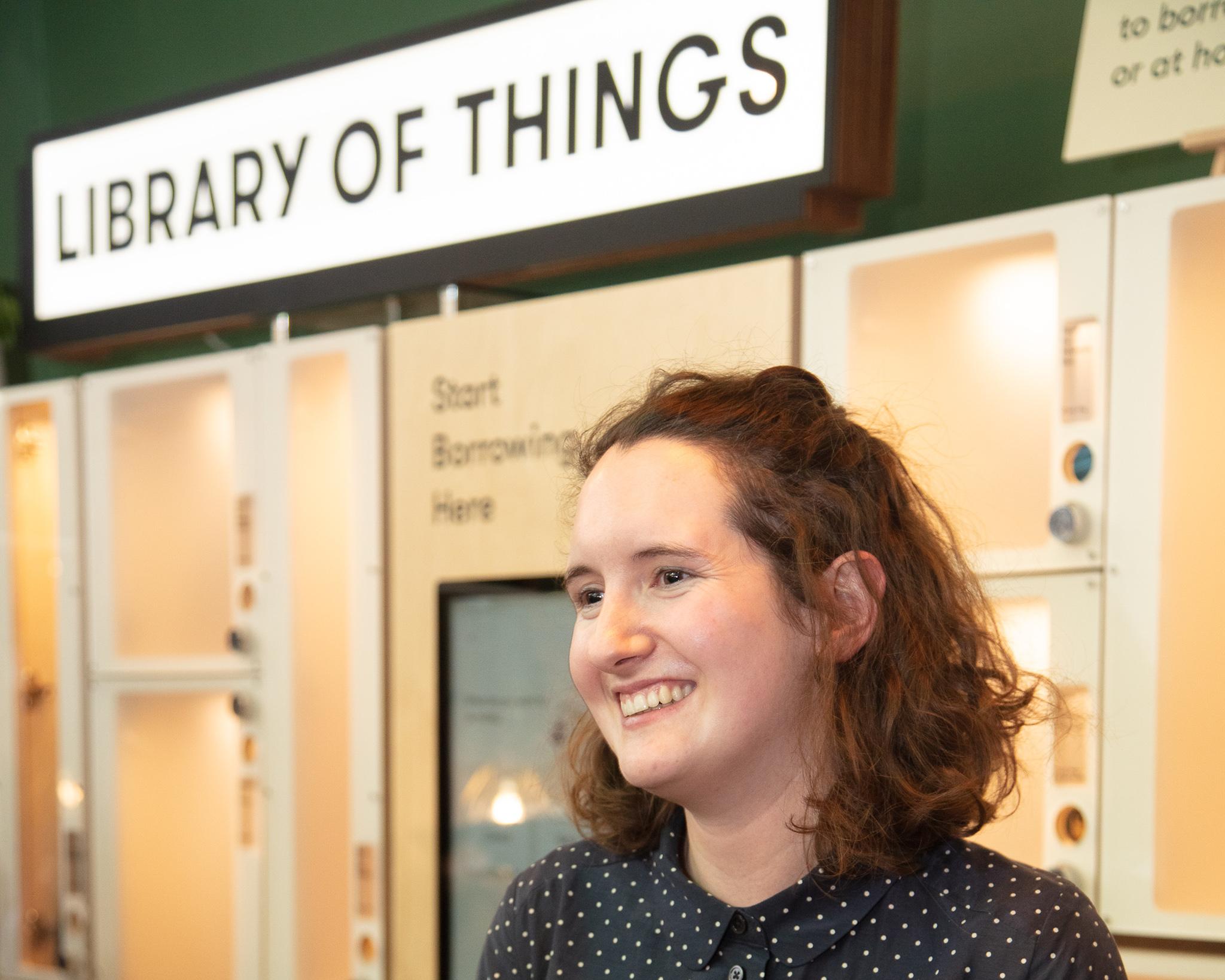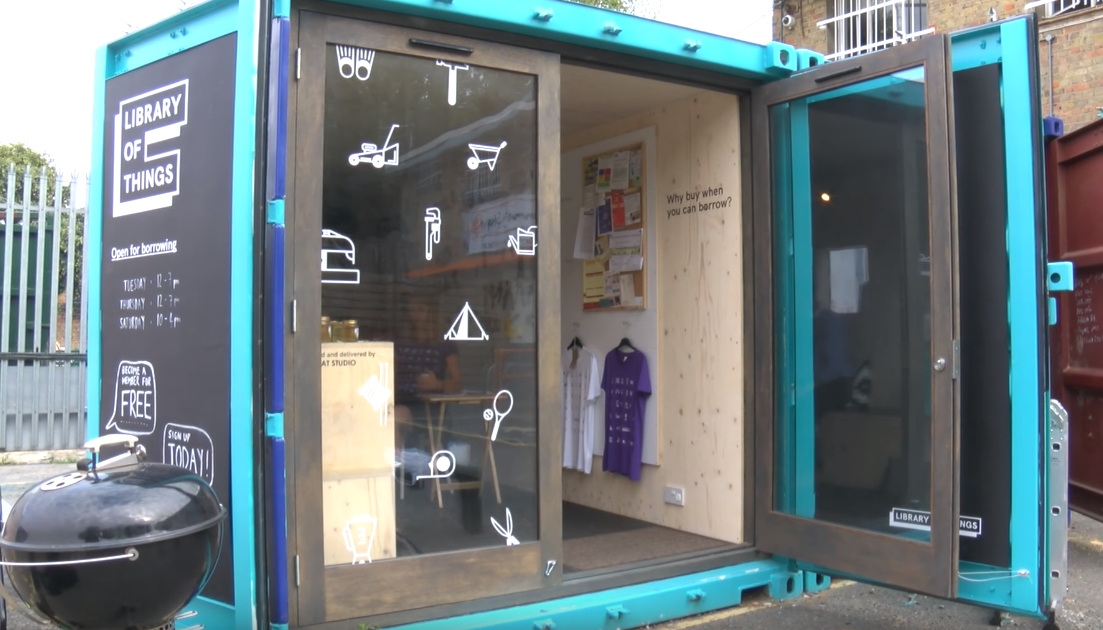Could the Library of Things cure our obsession with buying?
Hazel Sheffield speaks to co-founder Sophia Wyatt about making borrowing not just easier, but a way to bring people together

It’s just after lunchtime on a Tuesday in December at the Upper Norwood Library Hub, a community-run library that straddles five boroughs in south London.
By the window, a futuristic wall of plywood lockers features a screen announcing the Library of Things: a place to borrow useful homeware, DIY equipment and other goods that take up space and gather dust in the home.
There’s a PA system, a pasta maker and a sewing machine. A tile cutter, a carpet cleaner and a tent. The items are available to borrow for a £1 joining fee and as little as £7 a day. At 3.30pm, local resident Lindsey Pereria drops in with her baby in a buggy to pick up a carpet cleaner. “It’s a really good idea,” she says. “I’ll definitely get the carpet cleaner, because it’s very expensive to get people to come out and do it for you.”
Sophia Wyatt, a co-founder of the Library of Things, says their whole mission is making it better to borrow than buy. “We know it’s very convenient go to Argos and buy a drill for £20 or £30, but you’ll probably only use it once or twice, it will break on you and you’ll have to store it,” she says. “Or you can borrow one from us for £7 or £8 a day, learn how to use it and you’ll have the benefit of knowing that you’re making an environmental impact by not buying something and letting it go to waste.”
The Library of Things was brought to life in 2017, when 300 local people crowdfunded nearly £10,000 to bring it to Crystal Palace. In just 18 months of borrowing, the organisers reckon they have saved 22 tonnes of waste from landfill. The products available to borrow have been whittled down from around 400 potential appliances to around 50, after many months of testing.
They are hidden behind frosted, lit doors in a locker system designed by Seymourpowell, whose brief was to make something easy to operate, easy to make locally and joyful to use. The idea, Wyatt explains, is to make it as easy as possible for other communities, in libraries and elsewhere, to manufacture the locker system locally (to cut down on carbon emissions from transportation) and install it in libraries and other community spaces. Two further libraries are already lined up in 2020 in west London and south London, while the original Library of Things in Crystal Palace has heard from many other communities around the country hoping to install the system where they live.
Each time someone joins the library, they become part of a network of borrowers who are invited to skill-sharing events, like repair parties and mending meetups. “It’s more rewarding on an individual level, because you can join in with something in a light-touch way,” Wyatt says. “It’s like a trojan horse for bringing people together.”
The history of sharing libraries can be traced back to the Great Depression, when toy libraries emerged in Harlem, catering to young families who could not afford to buy their own, after a spate of cases of children being arrested for stealing toys.
Tool libraries, however, began to appear in the US during the Forties. A tool library established by the Rotary Club of Grosse Pointe, Michigan, in 1943 continues to operate out of the Grosse Pointe public library even today. In the Seventies, the idea spread to places such as Columbus, Ohio; Berkeley, California; and Cohoes, New York. However, there’s little evidence of the movement reaching the UK until the last decade, when the Edinburgh Tool Library opened in an old police box on Leith Walk, Edinburgh, in 2015.

Now Oxford, Frome, Stirling, Edinburgh and Totnes all have versions of a Library of Things. However, the locker system is a huge advance on previous iterations that require the library to be manned and organised by volunteers.
“People who are working in community-driven organisations are some of the greatest people, but they are often stretched because there isn’t enough funding in their work,” Wyatt says. “So a lot of work has gone into this simple kiosk and it should now be easy for a community to work with us and to set up their own Library of Things.”
Wyatt says she estimates the manufacture and installation costs, plus the start-up cost of buying all the equipment, to be around £30,000. “We encourage people to reach out for help with funding,” Wyatt says. “There’s always going to be a way to access funding that works for the community and works for us.”
Pereria found out about the Library of Things after visiting the library with her children. She says Upper Norwood Library Hub has been trying to get more people to come in with classes and events. She once took her husband to a sound bath session in the room above: “He liked it!” Library of Things has helped the Upper Norwood Library Hub to diversify its revenue through a guaranteed contribution to its rent and hiring spaces for skills workshops and other events.
Emily Jewell, hub director at the Upper Norwood Library Trust, says the revenue they receive from hosting the Library of Things helps the traditional library to survive. “As a community library hub we need to raise funds in order to survive – opening our own Library of Things seemed a perfect fit as it enabled us to serve our community, help our planet and raise revenue,” Jewell says. “When Library of Things offered to join us as operational partners we were very excited at the chance to partner and learn from the experts.”
Wyatt and the Library of Things team have developed relationships with manufacturers, including Bosch and North Face, to feed back information about the quality and popularity of products from customers.

They were recently able to advise North Face that a light-coloured backpack was less popular than other versions, because people were afraid it would get too dirty. “You’d be surprised but manufacturers often don’t actually know this,” she said. “They don’t have a direct relationship with consumers, they go via retailers and retailers might not have this information.”
The Library of Things might be seen as part of a much wider movement of businesses proving there are other ways to consume, including fashion companies such as Rent the Runway, a subscription fashion service that offers designer clothes for short periods of wear.
But Wyatt says the Library of Things is more than a simple sharing platform. She describes it as a Zipcar for things, rather than an Airbnb for things, because it offers consumers an alternative to buying new products, rather than encouraging sharing after purchase. “We’re preventative, rather than offering solutions after the fact,” she says. “We stop people from buying things.”
Join our commenting forum
Join thought-provoking conversations, follow other Independent readers and see their replies
Comments